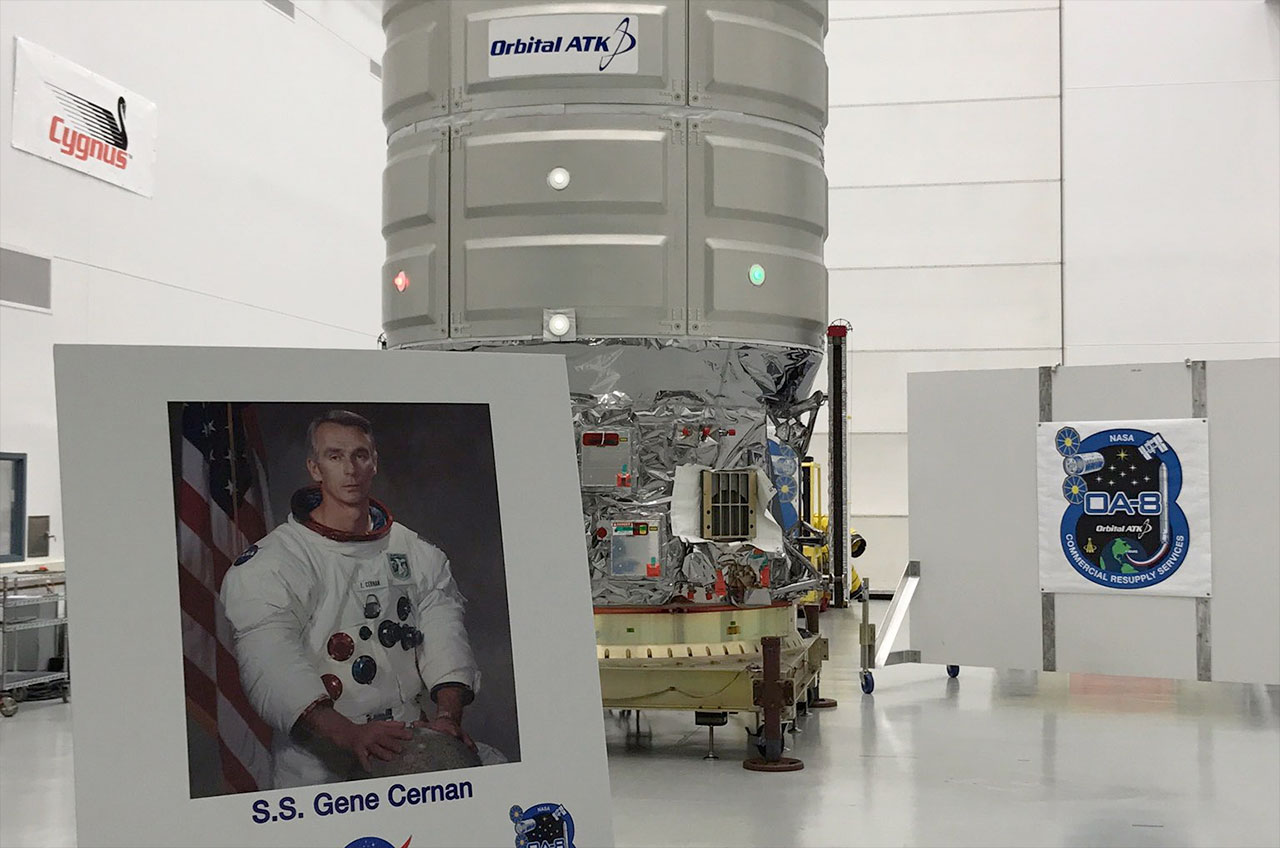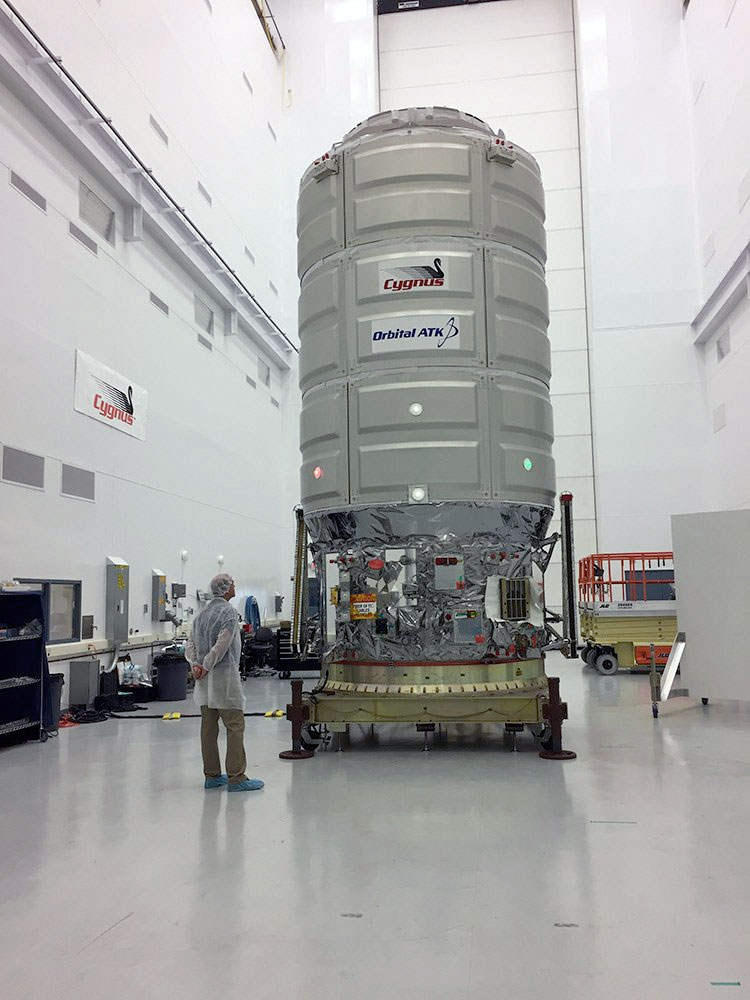S.S. Gene Cernan: Space Station Resupply Ship Named for Last Man on the Moon

The last human to step off the moon is the latest astronaut to be memorialized with the naming of a space station-bound cargo ship.
Gene Cernan, who commanded NASA's final Apollo moon landing mission in 1972, died at the age of 82 in January. Orbital ATK's next Cygnus commercial resupply spacecraft to launch honors Cernan's commitment to exploration and discovery.
"Today we announced that we're naming the OA-8 vehicle after Gene Cernan. It is the 'S.S. Gene Cernan,'" said Rick Mastracchio, Orbital ATK senior director of operations for the Commercial Resupply Services program and a former NASA astronaut, on Wednesday (Oct. 18). [Eugene Cernan: The Last Man on the Moon]
"[Eugene] Cernan's role in the development of America's space program ushered in a new era of human spaceflight that continues to make new scientific discoveries through the International Space Station." Orbital ATK described in a fact sheet posted to its website.
The S.S. Gene Cernan is targeted to lift off Nov. 11 aboard an Orbital ATK Antares 230 booster from the Mid-Atlantic Regional Spaceport at the NASA Wallops Flight Facility in Virginia. After arriving and being berthed to the station, the orbiting lab's crew will unpack the Cygnus of its cargo and, for the first time, use it to extend their science work areas.
The Cygnus spacecraft will be outfitted with TangoLab, a reconfigurable general microgravity research facility. "This exercise will demonstrate the ability to expand the station's capabilities for hosting experiments," stated Orbital ATK. [Orbital ATK's Cygnus Cargo Ships Explained (Infographic)]

The S.S. Gene Cernan will remain connected to the station for two weeks and then will depart to deploy 14 cubesats (small satellites), more than any prior mission. The Cygnus module will then perform a destructive re-entry into Earth's atmosphere over the Pacific Ocean.
Get the Space.com Newsletter
Breaking space news, the latest updates on rocket launches, skywatching events and more!
The flight of the Gene Cernan will mark the ninth Cygnus to be launched to resupply the International Space Station under a contract with NASA. Of the eight missions to date, all but one was successful.
The naming of the Cygnus continues a company tradition to name Orbital ATK's (formerly Orbital Sciences) missions for individuals who made contributions to the program. All of the Cygnus ships have been christened for astronauts.
Earlier Cygnus vehicles were named for astronauts David Low, Gordon Fullerton, Janice Voss, Deke Slayton (twice, including a Cygnus destroyed in a 2014 launch failure) and Rick Husband.
The most recent Cygnus, the S.S. John Glenn, named for the first American astronaut to orbit Earth, launched to the space stationon April 18. It was released from the orbital complex June 4 and supported a combustion experiment before being destroyed during re-entry on June 11.
In addition to being the last human to step off the moon's surface (to date), Cernan was the second U.S. astronaut to walk in space and one of only three people to fly to the moon twice. A veteran of three missions (Gemini 9, Apollo 10 and Apollo 17), Cernan logged more than 23 days in space, with more than 73 hours on the lunar surface.
The mission patch for the S.S. Gene Cernan (also referred to as OA-8) includes the NASA astronaut symbol as part of its design in reference of the late astronaut.
Cernan's fellow Apollo 17 moonwalker, Harrison Schmitt, serves on Orbital ATK's board of directors.
See Orbital ATK’s mission patch for the "S.S. Gene Cernan" OA-8 launch to the space station at collectSPACE.
Follow collectSPACE.com on Facebook and on Twitter at @collectSPACE. Copyright 2017 collectSPACE.com. All rights reserved.
Join our Space Forums to keep talking space on the latest missions, night sky and more! And if you have a news tip, correction or comment, let us know at: community@space.com.

Robert Pearlman is a space historian, journalist and the founder and editor of collectSPACE.com, a daily news publication and community devoted to space history with a particular focus on how and where space exploration intersects with pop culture. Pearlman is also a contributing writer for Space.com and co-author of "Space Stations: The Art, Science, and Reality of Working in Space” published by Smithsonian Books in 2018.In 2009, he was inducted into the U.S. Space Camp Hall of Fame in Huntsville, Alabama. In 2021, he was honored by the American Astronautical Society with the Ordway Award for Sustained Excellence in Spaceflight History. In 2023, the National Space Club Florida Committee recognized Pearlman with the Kolcum News and Communications Award for excellence in telling the space story along the Space Coast and throughout the world.










